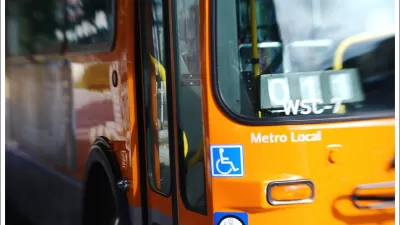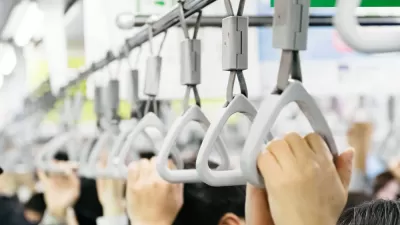One reason why buses are less popular than trains is buses' lack of "legibility": the ability of an occasional passenger to figure out how to get somewhere by bus. While subway or light rail passengers can look at a system map (which is usually present on a station wall) and figure out that a train to destination X shall arrive at their station reasonably soon, bus passengers typically have to invest time in getting schedules, and then pray that the schedule has not changed.
One reason why buses are less popular than trains is buses' lack of "legibility": the ability of an occasional passenger to figure out how to get somewhere by bus. While subway or light rail passengers can look at a system map (which is usually present on a station wall) and figure out that a train to destination X shall arrive at their station reasonably soon, bus passengers typically have to invest time in getting schedules, and then pray that the schedule has not changed.
In Jacksonville, Florida (where I lived from 2006 to 2009, and will probably return in 2010), the bus system is not particularly legible, partially because bus routes change once or twice a year.
For example, my former (and possibly future) Jacksonville neighborhood,
Mandarin, is served by one bus route. The route has experienced three significant changes in three years. Each time, the name of the bus route changes – first it was the J1, then it was the SS-9, now it is the CT1.
And the destinations served by the route change as well:although it has always gone from Mandarin (my neighborhood) to downtown, the intermediate routes have changed once a year. First it went directly to my workplace, then it went to an office park that is about a ten minute walk to the workplace, then it bypassed my workplace entirely, serving an entirely different neighborhood between Mandarin and downtown.
Such rapid service changes are not necessarily a problem for the most alert riders, the ones who check the bus system's web page (www.jtafla.com) every month or two to find out about possible service changes (or who do so when a sign on the bus informs them of impending service changes). But such constant service changes make it difficult for occasional or new riders to figure out where a bus goes and when,* and also make it impossible for would-be riders to use bus service to plan where to live.
By contrast, in Buffalo (a metropolitan area of roughly comparable size to Jacksonville) most bus routes today are very similar to the bus routes I used when I lived there in 1999: the route numbers are the same, they go to the same places, and they go at about the same times.
When I was visiting Memphis this summer, I encountered another annoying problem: irregular bus stops. Although I had discovered online which bus
goes to the airport, when I stopped on the street served by that bus, I found no bus stop. So I walked another block. And another. And another, until I found the bus stop. For a regular rider, irregular bus stops are not a problem; after a few rides, you know what streets have bus stops and what streets don't. But the occasional rider might be tempted to give up and take a cab, never having had the opportunity to become a frequent rider.
These sorts of problems tempt me to argue to say that buses
should stop every block and never change routes. But to be fair, the illegibility-inducing behavior of JTA and MATA (Memphis's bus system) is motivated by legitimate considerations. JTA changes routes so it can maximize ridership and speed up the commutes of the Mandarin-to-downtown commuters who have always made up the bulk of the bus route's ridership. (For example, the bus stopped running to my workplace because speed bumps slowed the commute by a few minutes). Similarly, reducing the number of bus stops no doubt makes the Memphis airport bus (which already takes an hour to get from downtown to the airport, because it takes a serpentine route though a wide variety of Memphis neighborhoods) run a bit less slowly.
So ultimately there is no one-size-fits-all right answer. Legibility is important, but must be weighed against efficiency. However, I think a weak system struggling for new riders should probably err a bit more on the side of legibility.
*Of course, this problem could be alleviated by placing bus
schedules at bus stops, as is frequently done in Toronto and New York City. But I realize that weaker bus systems such as Jacksonville's may lack the resources for such visionary steps.

Planetizen Federal Action Tracker
A weekly monitor of how Trump’s orders and actions are impacting planners and planning in America.

Restaurant Patios Were a Pandemic Win — Why Were They so Hard to Keep?
Social distancing requirements and changes in travel patterns prompted cities to pilot new uses for street and sidewalk space. Then it got complicated.

Map: Where Senate Republicans Want to Sell Your Public Lands
For public land advocates, the Senate Republicans’ proposal to sell millions of acres of public land in the West is “the biggest fight of their careers.”

Maui's Vacation Rental Debate Turns Ugly
Verbal attacks, misinformation campaigns and fistfights plague a high-stakes debate to convert thousands of vacation rentals into long-term housing.

San Francisco Suspends Traffic Calming Amidst Record Deaths
Citing “a challenging fiscal landscape,” the city will cease the program on the heels of 42 traffic deaths, including 24 pedestrians.

California Homeless Arrests, Citations Spike After Ruling
An investigation reveals that anti-homeless actions increased up to 500% after Grants Pass v. Johnson — even in cities claiming no policy change.
Urban Design for Planners 1: Software Tools
This six-course series explores essential urban design concepts using open source software and equips planners with the tools they need to participate fully in the urban design process.
Planning for Universal Design
Learn the tools for implementing Universal Design in planning regulations.
Heyer Gruel & Associates PA
JM Goldson LLC
Custer County Colorado
City of Camden Redevelopment Agency
City of Astoria
Transportation Research & Education Center (TREC) at Portland State University
Camden Redevelopment Agency
City of Claremont
Municipality of Princeton (NJ)






























